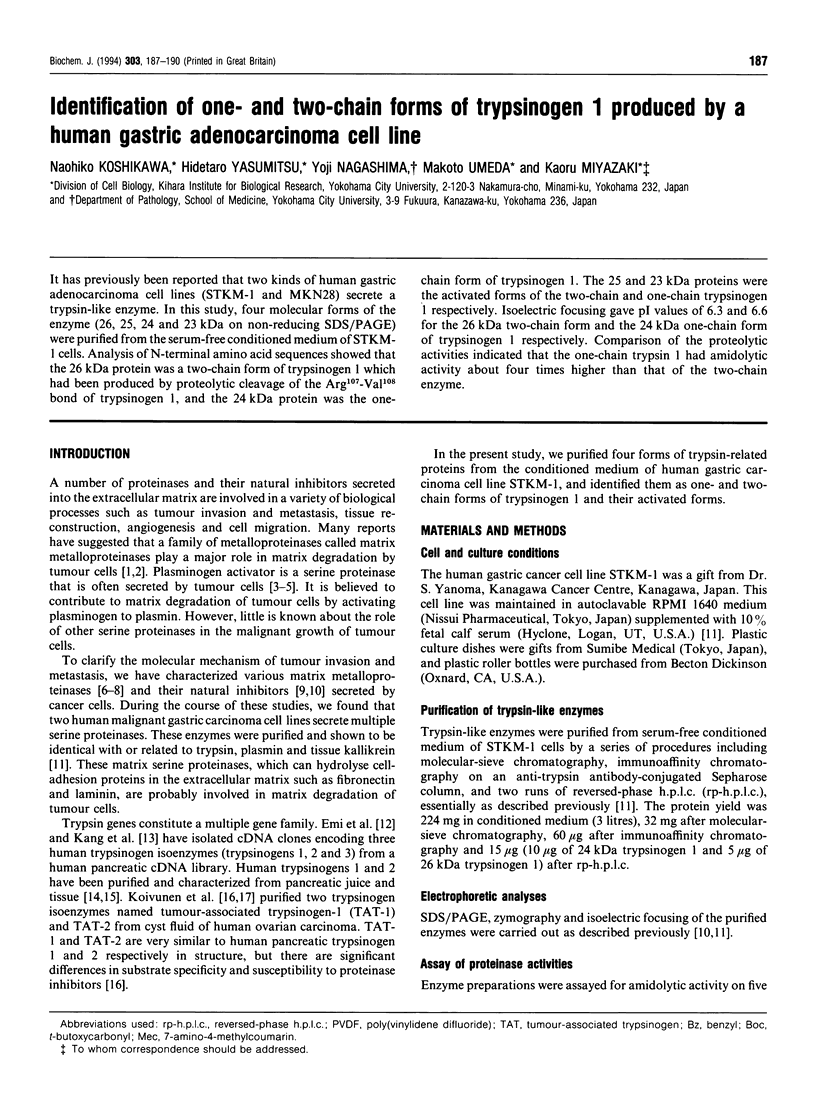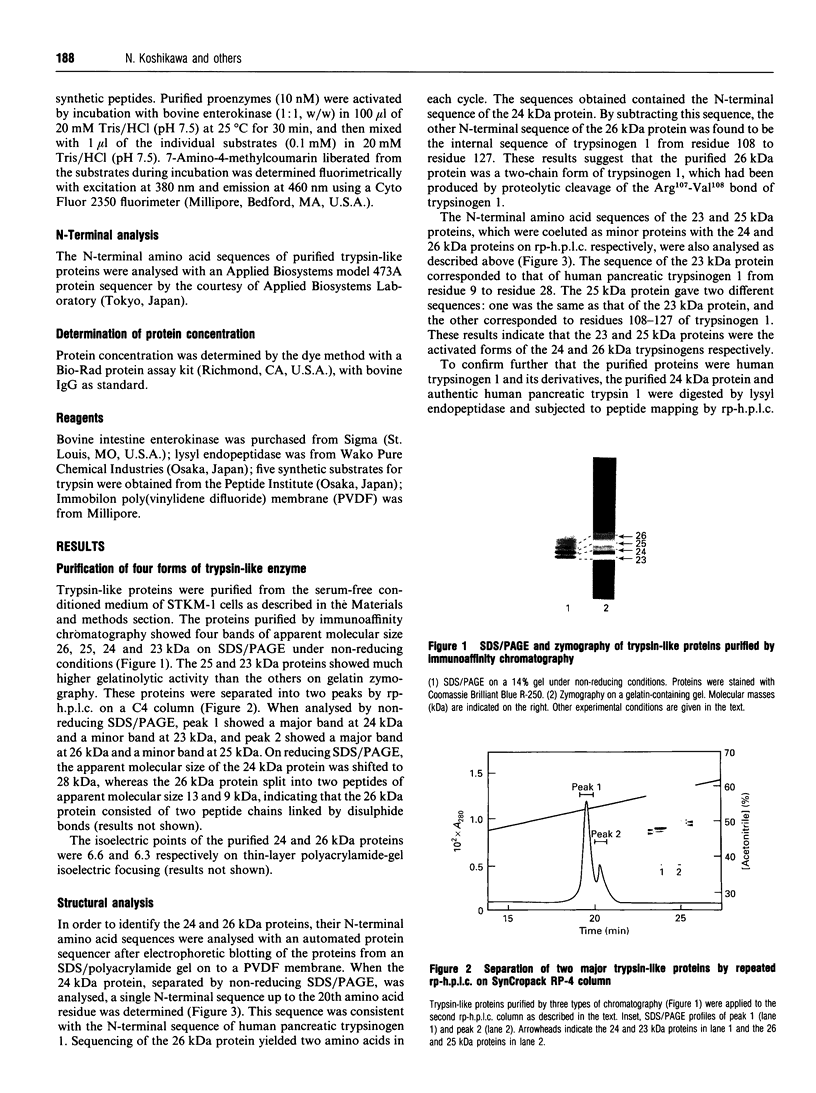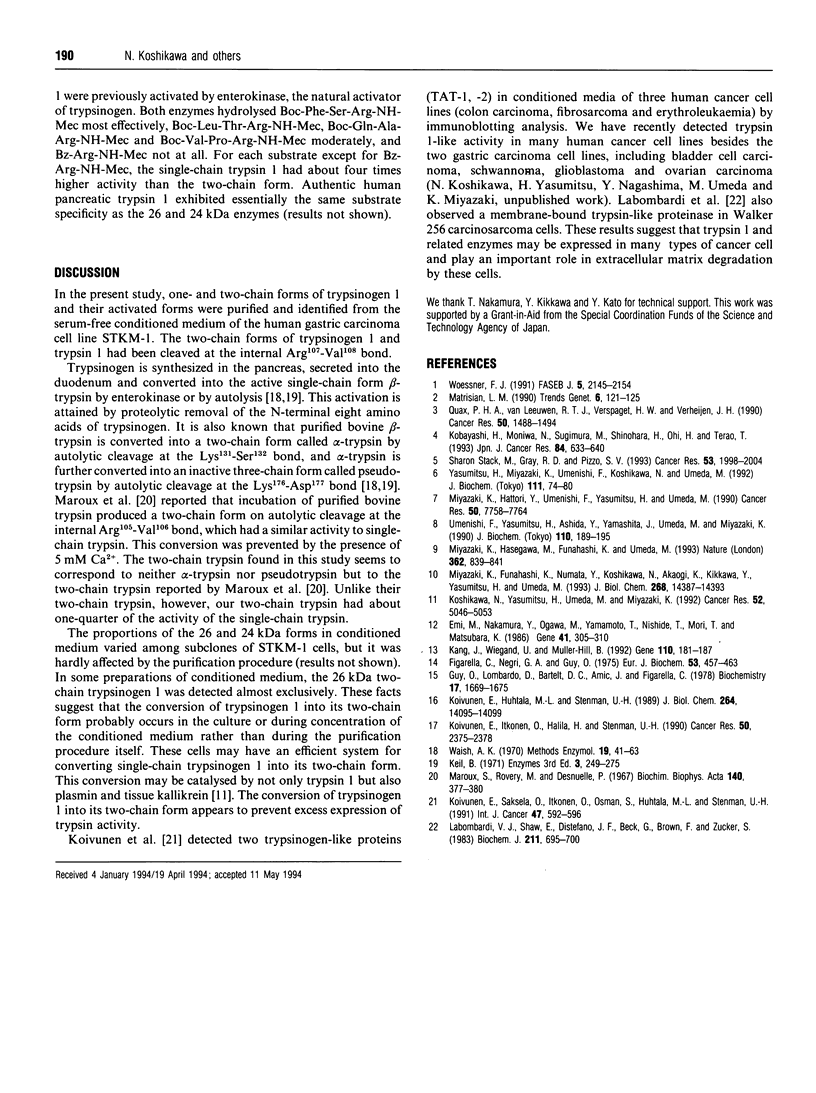Abstract
It has previously been reported that two kinds of human gastric adenocarcinoma cell lines (STKM-1 and MKN28) secrete a trypsin-like enzyme. In this study, four molecular forms of the enzyme (26, 25, 24 and 23 kDa on non-reducing SDS/PAGE) were purified from the serum-free conditioned medium of STKM-1 cells. Analysis of N-terminal amino acid sequences showed that the 26 kDa protein was a two-chain form of trypsinogen 1 which had been produced by proteolytic cleavage of the Arg107-Val108 bond of trypsinogen 1, and the 24 kDa protein was the one-chain form of trypsinogen 1. The 25 and 23 kDa proteins were the activated forms of the two-chain and one-chain trypsinogen 1 respectively. Isoelectric focusing gave pI values of 6.3 and 6.6 for the 26 kDa two-chain form and the 24 kDa one-chain form of trypsinogen 1 respectively. Comparison of the proteolytic activities indicated that the one-chain trypsin 1 had amidolytic activity about four times higher than that of the two-chain enzyme.
Full text
PDF



Images in this article
Selected References
These references are in PubMed. This may not be the complete list of references from this article.
- Emi M., Nakamura Y., Ogawa M., Yamamoto T., Nishide T., Mori T., Matsubara K. Cloning, characterization and nucleotide sequences of two cDNAs encoding human pancreatic trypsinogens. Gene. 1986;41(2-3):305–310. doi: 10.1016/0378-1119(86)90111-3. [DOI] [PubMed] [Google Scholar]
- Figarella C., Negri G. A., Guy O. The two human trypsinogens. Inhibition spectra of the two human trypsins derived from their purified zymogens. Eur J Biochem. 1975 May 6;53(2):457–463. doi: 10.1111/j.1432-1033.1975.tb04086.x. [DOI] [PubMed] [Google Scholar]
- Guy O., Lombardo D., Bartelt D. C., Amic J., Figarella C. Two human trypsinogens. Purification, molecular properties, and N-terminal sequences. Biochemistry. 1978 May 2;17(9):1669–1675. doi: 10.1021/bi00602a014. [DOI] [PubMed] [Google Scholar]
- Kang J., Wiegand U., Müller-Hill B. Identification of cDNAs encoding two novel rat pancreatic serine proteases. Gene. 1992 Jan 15;110(2):181–187. doi: 10.1016/0378-1119(92)90646-7. [DOI] [PubMed] [Google Scholar]
- Kobayashi H., Moniwa N., Sugimura M., Shinohara H., Ohi H., Terao T. Increased cell-surface urokinase in advanced ovarian cancer. Jpn J Cancer Res. 1993 Jun;84(6):633–640. doi: 10.1111/j.1349-7006.1993.tb02023.x. [DOI] [PMC free article] [PubMed] [Google Scholar]
- Koivunen E., Itkonen O., Halila H., Stenman U. H. Cyst fluid of ovarian cancer patients contains high concentrations of trypsinogen-2. Cancer Res. 1990 Apr 15;50(8):2375–2378. [PubMed] [Google Scholar]
- Koivunen E., Saksela O., Itkonen O., Osman S., Huhtala M. L., Stenman U. H. Human colon carcinoma, fibrosarcoma and leukemia cell lines produce tumor-associated trypsinogen. Int J Cancer. 1991 Feb 20;47(4):592–596. doi: 10.1002/ijc.2910470419. [DOI] [PubMed] [Google Scholar]
- Koshikawa N., Yasumitsu H., Umeda M., Miyazaki K. Multiple secretion of matrix serine proteinases by human gastric carcinoma cell lines. Cancer Res. 1992 Sep 15;52(18):5046–5053. [PubMed] [Google Scholar]
- LaBombardi V. J., Shaw E., DiStefano J. F., Beck G., Brown F., Zucker S. Isolation and characterization of a trypsin-like serine proteinase from the membranes of Walker 256 carcino-sarcoma cells. Biochem J. 1983 Jun 1;211(3):695–700. doi: 10.1042/bj2110695. [DOI] [PMC free article] [PubMed] [Google Scholar]
- Maroux S., Rovery M., Desnuelle P. An autolyzed and still active form of bovine trypsin. Biochim Biophys Acta. 1967 Jun 27;140(2):377–380. doi: 10.1016/0005-2795(67)90482-5. [DOI] [PubMed] [Google Scholar]
- Matrisian L. M. Metalloproteinases and their inhibitors in matrix remodeling. Trends Genet. 1990 Apr;6(4):121–125. doi: 10.1016/0168-9525(90)90126-q. [DOI] [PubMed] [Google Scholar]
- Miyazaki K., Funahashi K., Numata Y., Koshikawa N., Akaogi K., Kikkawa Y., Yasumitsu H., Umeda M. Purification and characterization of a two-chain form of tissue inhibitor of metalloproteinases (TIMP) type 2 and a low molecular weight TIMP-like protein. J Biol Chem. 1993 Jul 5;268(19):14387–14393. [PubMed] [Google Scholar]
- Miyazaki K., Hasegawa M., Funahashi K., Umeda M. A metalloproteinase inhibitor domain in Alzheimer amyloid protein precursor. Nature. 1993 Apr 29;362(6423):839–841. doi: 10.1038/362839a0. [DOI] [PubMed] [Google Scholar]
- Miyazaki K., Hattori Y., Umenishi F., Yasumitsu H., Umeda M. Purification and characterization of extracellular matrix-degrading metalloproteinase, matrin (pump-1), secreted from human rectal carcinoma cell line. Cancer Res. 1990 Dec 15;50(24):7758–7764. [PubMed] [Google Scholar]
- Quax P. H., van Leeuwen R. T., Verspaget H. W., Verheijen J. H. Protein and messenger RNA levels of plasminogen activators and inhibitors analyzed in 22 human tumor cell lines. Cancer Res. 1990 Mar 1;50(5):1488–1494. [PubMed] [Google Scholar]
- Stack M. S., Gray R. D., Pizzo S. V. Modulation of murine B16F10 melanoma plasminogen activator production by a synthetic peptide derived from the laminin A chain. Cancer Res. 1993 May 1;53(9):1998–2004. [PubMed] [Google Scholar]
- Umenishi F., Umeda M., Miyazaki K. Efficient purification of TIMP-2 from culture medium conditioned by human hepatoma cell line, and its inhibitory effects on metalloproteinases and in vitro tumor invasion. J Biochem. 1991 Aug;110(2):189–195. doi: 10.1093/oxfordjournals.jbchem.a123555. [DOI] [PubMed] [Google Scholar]
- Woessner J. F., Jr Matrix metalloproteinases and their inhibitors in connective tissue remodeling. FASEB J. 1991 May;5(8):2145–2154. [PubMed] [Google Scholar]
- Yasumitsu H., Miyazaki K., Umenishi F., Koshikawa N., Umeda M. Comparison of extracellular matrix-degrading activities between 64-kDa and 90-kDa gelatinases purified in inhibitor-free forms from human schwannoma cells. J Biochem. 1992 Jan;111(1):74–80. doi: 10.1093/oxfordjournals.jbchem.a123721. [DOI] [PubMed] [Google Scholar]




